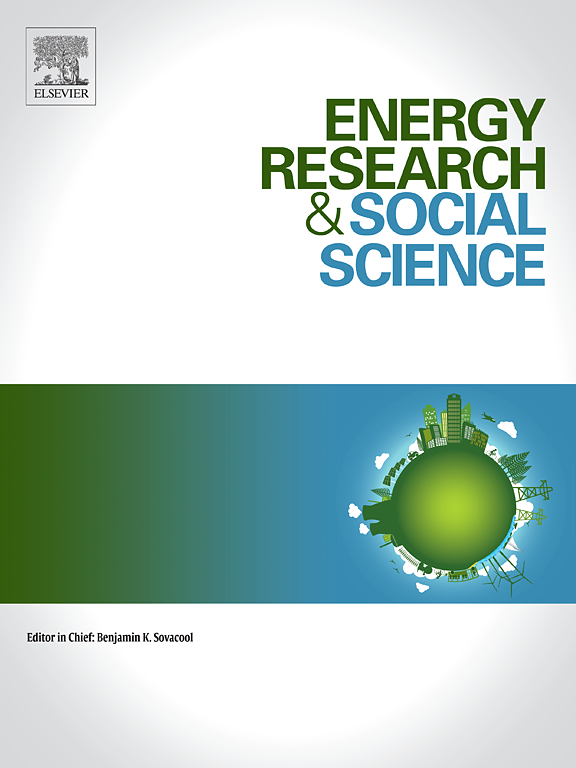The prepay “poverty premium”: Perspective on Australia's Northern Territory prepayment tariff
IF 6.9
2区 经济学
Q1 ENVIRONMENTAL STUDIES
引用次数: 0
Abstract
The affordability of prepaid electricity - in common use in jurisdictions where the proportion of Indigenous Australians living remotely is greatest and Indigenous poverty rates are uniquely high (above 40 %) - represents an exceptional yet under examined aspect of the nation's energy transition. Here we explore a previously overlooked element of the prepaid electricity system in Australia's remote and regional Northern Territory (NT): how it disproportionately burdens high consumption households with a “poverty premium”. Our findings reveal financial disparities arising from the application of two discrete electricity payment types operating throughout the Territory since 1998: the prepayment tariff versus the residential tariff plus fixed daily supply charge. By appraising three decades of NT Electricity Pricing Orders (EPOs) we highlight the mechanism by which prepay households using more than a threshold rate of electricity - that has varied over time - are penalized financially. Using known rates of household energy consumption, we demonstrate that while a subset of households are better off, prepay imposes an annual premium of AUD$57–$253 on those with higher consumption (26-48kWh daily in 2018/19) - homes that incongruously experience both an elevated risk of disconnection during temperature extremes and greater energy expenses than all other Territorians. Our perspective complicates the trope that prepay is a fairer way to distribute energy costs in Australia's most remote jurisdiction.
预付“贫困溢价”:对澳大利亚北领地预付关税的观察
预付电力的可负担性——在偏远地区的澳大利亚土著居民比例最大,土著贫困率特别高(超过40%)的司法管辖区普遍使用——代表了国家能源转型的一个特殊但尚待研究的方面。在这里,我们探讨了澳大利亚偏远地区北领地(NT)预付电力系统中一个以前被忽视的因素:它是如何不成比例地给高消费家庭带来“贫困溢价”的。我们的研究结果显示,自1998年以来,全港各地采用两种不同的电费支付方式,即预付电费和住宅电费加上固定的每日电费,从而导致财务差异。通过评估三十年的北省电价令(epo),我们强调了使用超过阈值电价(随时间变化)的预付家庭受到经济惩罚的机制。使用已知的家庭能源消耗率,我们证明,虽然一小部分家庭的生活状况较好,但预付费对那些消费较高(2018/19年每天26-48千瓦时)的家庭征收57 - 253澳元的年溢价,这些家庭在极端温度期间经历了更高的断电风险,并且能源费用高于所有其他领土居民。在澳大利亚最偏远的司法管辖区,预付是一种更公平的分配能源成本的方式,我们的观点使这种说法变得复杂。
本文章由计算机程序翻译,如有差异,请以英文原文为准。
求助全文
约1分钟内获得全文
求助全文
来源期刊

Energy Research & Social Science
ENVIRONMENTAL STUDIES-
CiteScore
14.00
自引率
16.40%
发文量
441
审稿时长
55 days
期刊介绍:
Energy Research & Social Science (ERSS) is a peer-reviewed international journal that publishes original research and review articles examining the relationship between energy systems and society. ERSS covers a range of topics revolving around the intersection of energy technologies, fuels, and resources on one side and social processes and influences - including communities of energy users, people affected by energy production, social institutions, customs, traditions, behaviors, and policies - on the other. Put another way, ERSS investigates the social system surrounding energy technology and hardware. ERSS is relevant for energy practitioners, researchers interested in the social aspects of energy production or use, and policymakers.
Energy Research & Social Science (ERSS) provides an interdisciplinary forum to discuss how social and technical issues related to energy production and consumption interact. Energy production, distribution, and consumption all have both technical and human components, and the latter involves the human causes and consequences of energy-related activities and processes as well as social structures that shape how people interact with energy systems. Energy analysis, therefore, needs to look beyond the dimensions of technology and economics to include these social and human elements.
 求助内容:
求助内容: 应助结果提醒方式:
应助结果提醒方式:


